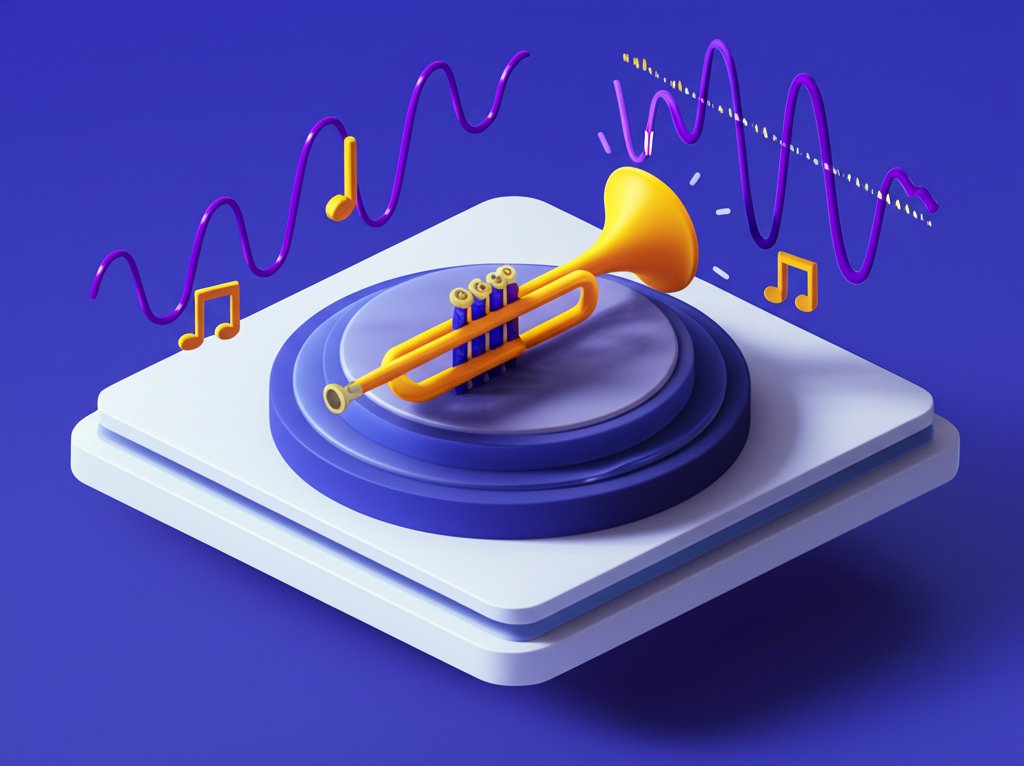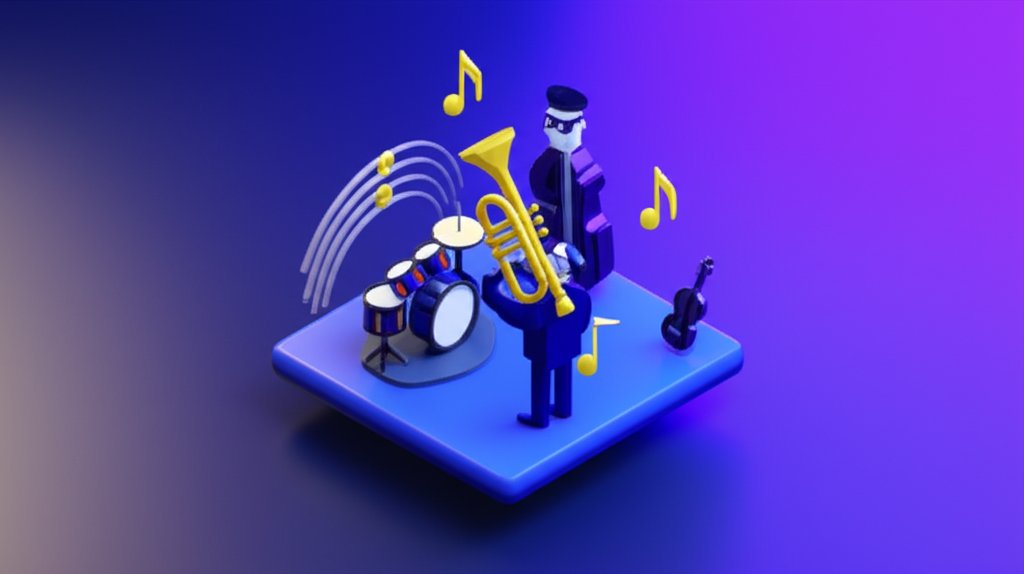In the pantheon of jazz, few figures cast a shadow as vibrant and sprawling as John Birks Gillespie. More famously known as “Dizzy,” this trumpet virtuoso didn’t just play music; he redefined it, bending notes and genres with the same audacious spirit that famously bent his trumpet’s bell. He was a force of nature—a mischievous grin masking a brilliant musical mind, a technical wizard who became the very embodiment of the bebop revolution. If you’re ready to unravel the complex harmonies and swinging rhythms of one of jazz’s most influential architects, and discover the true story behind that iconic bent trumpet, prepare to dive deep into the world of a true jazz trumpet pioneer. This article will explore how Dizzy Gillespie engineered a seismic shift in music, leaving an indelible mark as a global ambassador for jazz.
Early Life & The Genesis of a Jazz Trumpet Master
Born in Cheraw, South Carolina, on October 21, 1917, John Birks Gillespie was the youngest of nine children in a family deeply rooted in music. His father, a local bandleader, ensured that instruments were always within reach, sparking an early fascination that would shape his destiny.
From South Carolina Roots to Self-Taught Genius
While formal training was scarce, Gillespie’s innate talent was undeniable. By the age of four, he was already experimenting on the piano, and by twelve, the trombone had captured his attention. However, it was the jazz trumpet that truly stole his heart. Displaying an astonishing ability to learn by ear, Dizzy immersed himself in the sounds around him, absorbing influences from ragtime to swing. He was largely self-taught, developing a unique approach that prioritized instinct, experimentation, and a relentless pursuit of new sonic possibilities. This unconventional education laid the groundwork for a musician who would consistently challenge norms and forge his own path.
The Formative Years: Big Bands and Budding Innovation
Gillespie’s journey quickly led him north. By the mid-1930s, he was cutting his teeth in Philadelphia’s burgeoning jazz scene before moving to New York City in 1937. It was here, playing in prominent big bands like those led by Frankie Fairfax, Teddy Hill, and Cab Calloway, that his distinctive style began to coalesce. Known for his showmanship and playful onstage antics, the nickname “Dizzy” perfectly captured his effervescent personality. Yet, beneath the surface of the “clown prince” lay a restless innovator, already experimenting with the advanced harmonies and rhythmic complexities that would soon explode into bebop. He absorbed the fast tempos and virtuosic improvisation of trumpet legends like Roy Eldridge, but always pushed further, seeking to inject his own unpredictable twists into the established swing framework.
The Bebop Revolution: Forging a New Jazz Trumpet Sound
The 1940s marked a pivotal turning point in jazz history, and at its epicenter stood Dizzy Gillespie, co-piloting a musical revolution that swept away the familiar sounds of swing and ushered in the era of bebop.
The Minton’s Playhouse Incubator: Birthplace of Bebop
As World War II raged, an underground movement was brewing in the dimly lit clubs of Harlem, particularly at Minton’s Playhouse. Here, after hours, like-minded musicians gathered to push the boundaries of jazz. Away from the commercial pressures of big bands, they experimented freely, developing a complex, challenging style of music. Dizzy Gillespie was a central figure in these late-night sessions, alongside peers like pianist Thelonious Monk, drummer Kenny Clarke, and crucially, saxophonist Charlie Parker. These clandestine jam sessions were the crucible in which bebop was forged.
Charlie Parker, Dizzy, and the Architects of Modern Jazz
The partnership between Dizzy Gillespie and Charlie Parker was nothing short of legendary. Their musical chemistry was explosive, a perfect synergy of Gillespie’s harmonic sophistication and Parker’s melodic genius. Together, they codified the language of bebop, transforming it from an experimental idea into a coherent, revolutionary art form. Gillespie, with his profound understanding of music theory and harmony, was often the teacher, patiently explaining the intricate chord changes and rhythmic figures that defined the new sound to other musicians. He translated the intellectual underpinnings of bebop into accessible, yet still exhilarating, musical statements on his jazz trumpet.
Defining Bebop: Speed, Harmony, and Improvisational Freedom
Bebop was a radical departure from the dance-oriented swing music that preceded it. It was characterized by:
- Blazing Tempos: Often incredibly fast, pushing the limits of technical proficiency.
- Complex Harmonies: Incorporating extended chords, altered scales, and dissonances previously uncommon in jazz.
- Intricate Melodies: Angular, surprising melodic lines that often defied conventional song structures.
- Virtuosic Improvisation: Soloists were given unprecedented freedom to explore harmonic and rhythmic landscapes, often at breakneck speed.
- Rhythmic Innovation: Drummers moved away from strict timekeeping, providing more interactive and syncopated accompaniment.
Dizzy Gillespie’s jazz trumpet became the quintessential voice of this sound. His solos were dazzling displays of speed, agility, and harmonic daring, soaring into the trumpet’s extreme upper register and navigating complex changes with effortless grace. He wasn’t just playing notes; he was painting vivid, unpredictable sonic tapestries that demanded attention and challenged listeners to engage with jazz on a deeper, more intellectual level.
The Iconic Bent Trumpet: Accident, Innovation, and Signature Style
Few instruments are as instantly recognizable as Dizzy Gillespie’s bent trumpet. More than a mere curiosity, it became an extension of his audacious personality and a visual emblem of his groundbreaking approach to jazz.
The Fateful Incident of 1953
The origin story of the bent trumpet is a classic jazz legend. In 1953, during a birthday party for his wife, Lorraine, an accident occurred. While the trumpet was left on a stand, someone (accounts vary, but often cited as fellow musicians or even Dizzy himself, falling on it) inadvertently sat on it, bending the bell upwards at a distinctive 45-degree angle. Most musicians would have been devastated, rushing to find a replacement or repair. But Dizzy Gillespie, ever the iconoclast, played it.
Perceived Acoustic Advantage and Visual Brand
Upon playing the damaged instrument, Dizzy noticed something intriguing. He reportedly found that the upturned bell projected the sound differently, making it easier for him to hear himself on stage and, perhaps, directing the sound more effectively towards the audience. Whether this was a genuine acoustic phenomenon or simply the power of suggestion, the bent trumpet quickly became more than just a damaged instrument—it became a deliberate choice.
It transformed into an unmistakable part of his visual identity, as iconic as his puffed cheeks or his signature scat singing. The bent trumpet was a perfect metaphor for his music: unconventional, surprising, and always pushing the boundaries of what was expected. It symbolized his willingness to embrace the unexpected and turn an accident into a unique artistic statement. He even had custom-made “bent” trumpets crafted to his specifications for the remainder of his career.
The Bent Trumpet’s Legacy as a Symbol of Unorthodoxy
The bent trumpet became a powerful symbol for Dizzy Gillespie’s entire career. It represented:
- Innovation through Accident: Turning a mishap into an advantage.
- Individualism: A refusal to conform to traditional aesthetics or performance standards.
- Showmanship: An instantly recognizable signature that enhanced his already charismatic stage presence.
- Accessibility: It made him visually distinctive and memorable, helping to popularize him and, by extension, bebop, to a wider audience.
It was a physical manifestation of the spirit of bebop itself – a music that broke the rules, challenged conventions, and always sought a new angle.
Dizzy Gillespie’s Sonic Palette: Technique, Innovation, and Influence
Dizzy Gillespie’s impact transcended his role as a bebop pioneer. His technical mastery of the jazz trumpet, coupled with his relentless spirit of innovation, broadened the horizons of jazz in profound ways, influencing generations of musicians.
Mastering the Trumpet: Virtuosity and Range
Dizzy’s trumpet playing was characterized by breathtaking virtuosity. He possessed:
- Exceptional Range: Effortlessly navigating from the instrument’s lowest notes to its highest, often hitting stratospheric tones.
- Unparalleled Speed and Agility: Executing rapid-fire runs and intricate melodic phrases with clarity and precision.
- Harmonic Sophistication: His solos were always harmonically imaginative, employing extended chords, substitute harmonies, and a deep understanding of music theory.
- Rhythmic Force: His phrasing was incredibly dynamic, full of surprising accents and syncopations that propelled the music forward.
- Vibrato and Tone: He developed a strong, distinctive trumpet tone, full of warmth yet capable of brilliant, piercing intensity.
Beyond mere technical prowess, Dizzy Gillespie played with an infectious joy and playful wit that shone through every note. His solos were conversations, full of call-and-response, humor, and profound musical statements.
Afro-Cuban Jazz: A Rhythmic Fusion
Always looking beyond the established boundaries of jazz, Dizzy Gillespie was a visionary in incorporating Afro-Cuban rhythms and instrumentation into his music. He discovered kindred spirits in Cuban percussionists like Chano Pozo, resulting in a groundbreaking fusion that became known as Afro-Cuban jazz or Cubop. Tunes like “Manteca” and “Tin Tin Deo” became iconic examples of this cross-cultural fertilization, introducing new rhythmic complexity, percussive textures, and melodic flavors to the jazz lexicon. This pioneering effort demonstrated his belief in jazz as a universal language, capable of absorbing and transforming influences from around the globe, and significantly expanded the sonic possibilities of the jazz trumpet within larger ensembles.
Mentorship and the Next Generation of Jazz Trumpeters
Dizzy Gillespie was a generous and influential mentor. Unlike some artists who guarded their secrets, Dizzy was eager to teach and share his knowledge of bebop. He patiently explained complex harmonic concepts to younger musicians, always encouraging them to find their own voice while mastering the new idiom. His influence can be heard in an astonishing array of subsequent jazz trumpet greats, including:
- Miles Davis: Who absorbed bebop from Dizzy before forging his own cool and modal styles.
- Jon Faddis: A virtuoso trumpeter often hailed as a spiritual successor due to his own high-note prowess.
- Clifford Brown: Who carried the torch of bebop’s technical brilliance.
- Arturo Sandoval: A virtuoso Cuban trumpeter who credits Dizzy as a lifelong inspiration and mentor, particularly in Afro-Cuban jazz.
His open generosity helped ensure that the flame of innovation he ignited with bebop continued to burn brightly in the hands of new generations.
Beyond the Notes: Dizzy Gillespie, Ambassador of Jazz

Dizzy Gillespie was more than just a brilliant musician; he was a cultural icon, a charismatic personality who brought jazz to the world stage and championed its power to connect people across divides.
A Playful Persona with a Serious Mission
His famous “Dizzy” nickname, his perpetually puffed cheeks (a result of his unique embouchure), his scat singing, and his ever-present wit made him an unforgettable performer. He embraced his role as an entertainer, using humor and showmanship to disarm audiences and draw them into the often-complex world of bebop. Yet, beneath the playful exterior lay a profound intellectual and a serious commitment to his art and its greater purpose. He believed deeply in the power of music to foster understanding and peace.
Cultural Diplomacy on a Global Stage
In 1956, the U.S. State Department recognized Dizzy Gillespie’s unique ability to connect with people and appointed him as a “jazz ambassador.” Leading his big band, he embarked on groundbreaking tours to the Middle East, South America, and Eastern Europe. These tours were not just concerts; they were acts of cultural diplomacy, using the universal language of jazz to bridge political and cultural divides during the height of the Cold War.
John Birks Gillespie proved that music could transcend language barriers and ideological differences, showcasing the vibrancy and freedom inherent in American culture. His tours were wildly successful, earning him international acclaim and cementing his status as a global icon. He wasn’t just playing jazz trumpet; he was building bridges with every note.
Political Aspirations and Social Commentary
In 1964, in a truly Dizzy Gillespie move, he famously ran for President of the United States. While largely a symbolic gesture, it was a powerful statement that drew attention to civil rights issues and social justice concerns. His platform included appointing Duke Ellington as Secretary of State and Miles Davis as head of the CIA. This political foray, imbued with his characteristic humor, underscored his belief in the transformative power of art and his commitment to a more just world. Throughout his life, he used his platform to advocate for racial equality and human rights, demonstrating that the artistry of a bebop pioneer could extend far beyond the bandstand.
A Lasting Legacy: The Enduring Impact of a Bebop Visionary
Dizzy Gillespie’s journey concluded on January 6, 1993, but his impact on music, culture, and the very fabric of jazz remains as vital and resonant as ever. He left behind a legacy that continues to inspire and challenge musicians worldwide.
Recordings, Compositions, and Enduring Standards
His discography is a treasure trove of bebop brilliance and beyond. Albums like “Shaw ‘Nuff,” “Groovin’ High,” “Salt Peanuts,” and the groundbreaking “Cubana Be, Cubana Bop” are considered essential listening for any jazz enthusiast. His compositions, instantly recognizable for their intricate melodies and harmonic sophistication, became standards in the jazz repertoire, performed and reinterpreted by countless artists. From blisteringly fast solos to soulful ballads, his recordings showcase the full breadth of his genius on the jazz trumpet.
The Evolution of Jazz Post-Bebop
Bebop, largely conceived by John Birks Gillespie and Charlie Parker, irrevocably changed the course of jazz. It provided a new vocabulary for improvisation and harmonic exploration that influenced every subsequent jazz style, from cool jazz and hard bop to modal jazz and fusion. Without the groundwork laid by Dizzy and his peers, modern jazz as we know it would simply not exist. His vision opened doors for countless musicians to explore new territories, demonstrating that jazz was an ever-evolving art form.
Why Dizzy Still Matters Today
Dizzy Gillespie’s influence endures because he embodied the spirit of jazz itself: innovation, improvisation, and an unyielding commitment to personal expression. His music continues to challenge listeners, while his infectious energy and pioneering spirit serve as a beacon for aspiring artists. The story of the bent trumpet reminds us that sometimes, the most profound innovations arise from unexpected places, and that true genius lies in the ability to turn disadvantage into distinction. He taught us that music is not just about technique; it’s about passion, pushing boundaries, and sharing joy.
So, the next time you hear the thrilling complexities of bebop, or witness a trumpet player soar to impossible heights, remember the smiling face and the upturned bell of Dizzy Gillespie—the jazz trumpet maestro whose vision, wit, and audacity truly made him a global music maverick.
FAQ Section: Unpacking Dizzy’s World

What was John Birks Gillespie’s nickname?
John Birks Gillespie was famously known by his nickname, “Dizzy.” The moniker was reportedly given to him in his younger days due to his wild, unpredictable, and often playful personality and stage antics.
How did Dizzy Gillespie’s trumpet get bent?
The iconic bent trumpet was the result of an accident in 1953. During a party for his wife, Lorraine, a guest (or, in some accounts, Dizzy himself) accidentally sat on his trumpet, bending the bell upwards. Instead of replacing it, Dizzy Gillespie found he liked the sound projection and the unique visual, making it his signature instrument.
What is Bebop jazz?
Bebop is a style of jazz that emerged in the 1940s, characterized by fast tempos, complex chord progressions, challenging harmonies, and virtuosic improvisation. It was developed by musicians like Dizzy Gillespie and Charlie Parker, and marked a significant departure from the more dance-oriented swing music, focusing instead on artistic expression and technical mastery.
Who were Dizzy Gillespie’s main collaborators in developing bebop?
Dizzy Gillespie’s most significant collaborator in developing bebop was saxophonist Charlie Parker. Other key figures in the early bebop scene included pianist Thelonious Monk and drummer Kenny Clarke, who frequently jammed with Dizzy and Parker in Harlem’s after-hours clubs like Minton’s Playhouse.
What made Dizzy Gillespie a unique jazz trumpet player?
Dizzy Gillespie was unique for his astounding technical virtuosity, particularly his ability to navigate the extreme upper registers of the jazz trumpet with speed and clarity. His playing was also marked by a profound harmonic sophistication, rhythmic inventiveness, and an infectious, joyful energy. His incorporation of Afro-Cuban rhythms and his iconic bent trumpet further set him apart.
What was Dizzy Gillespie’s contribution to music?
Dizzy Gillespie’s contributions to music are vast: he was a co-founder and leading voice of bebop, fundamentally changing the direction of jazz; he pioneered Afro-Cuban jazz, expanding its rhythmic and harmonic vocabulary; he was a brilliant composer and arranger; and he served as a global ambassador for jazz, using music to bridge cultural divides. His spirit of innovation and mentorship continues to influence musicians worldwide.










